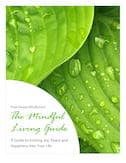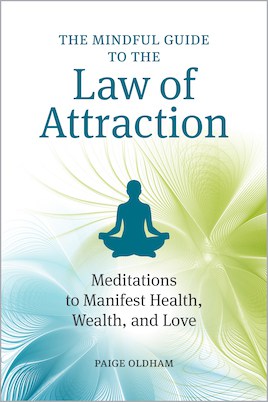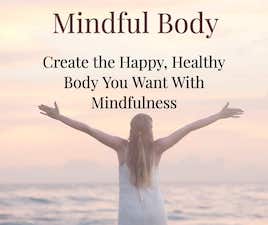Feeling depressed about your future? Is anxiety keeping you from enjoying your life?
Strong negative emotions can smother the joy and happiness that’s always inside you.
While neither of these feelings can be turned off like a light switch, there is a practice that can change your life in dramatic and positive ways over time.
It’s mindfulness.
[If your feelings of depression or anxiety are more serious, you might benefit from working with a professional who utilizes Mindfulness-Based Cognitive Therapy (MBCT) or Mindfulness-Based Stress Reduction (MBSR). Both are clinically proven to help those with more severe depression and anxiety.]
How can mindfulness turn your world around? Let’s look at its definition:
Mindfulness is a way of paying attention to and seeing clearly whatever is happening in our lives. It will not eliminate life’s pressures, but it can help us respond to them in a calmer manner that benefits our heart, head, and body.
It helps us recognize and step away from habitual, often unconscious, emotional and physiological reactions to everyday events. It provides us with a scientifically researched approach to cultivating clarity, insight, and understanding. Practicing mindfulness allows us to be fully present in our life and work and improve our quality of life. ~ Mindfulnet.org
In a nutshell, mindfulness is noticing without judging.
In order to notice, you need to pause all the racing thoughts that seem to constantly dance around in your head. It only takes a moment. A breath.
Pausing allows you to be present to whatever is actually happening. It helps you to see the difference between what’s actually happening and the stories you’re creating about what’s happening.
Pause to notice:
- What you’re doing
- What you’re thinking or focusing on
- How you’re responding to your environment
- What stories you’re making up about what’s going on
- How you’re feeling emotionally
- How those emotions feel in your body
The most important aspect of mindfulness is to do all this without judging. This means that everything simply is.
There’s no right or wrong, good or bad, stupid or smart, enough or inadequate, ugly or beautiful. All of that, all the judging, is the story you’re telling yourself. It’s how you’re deciding things are.
If these stories help you to feel better, then feel free to continue with them.
If the stories make you feel depressed, anxious or any other emotion that you don’t want, consider this pause your opportunity to make up a new story.
My Journey
Many years ago I lived with depression. I grew up in a family where it wasn’t safe to be myself or express my emotions. I learned to stuff my emotions down and eventually forgot how to feel them.
I thought that, in so many ways, I wasn’t enough. Regardless of what I achieved, I was never enough.
It took years of therapy, personal development and wanting to change in order to live life the way I do today.
To change something, you have to be aware of the thing you want to change.
Along my journey, the biggest lesson I learned is this:
Nothing in your life changes until you change.
Let me repeat that.
Nothing in your life changes until you change.
Of course, I’m human so it took me a while to figure it out.
Identifying My Patterns
At first, I did what I learned from my parents: I blamed all my problems on the people closest to me and wondered why my relationships were a disaster. If only those people would meet my expectations of them, my life would be so much better.
I think we all know how well that works. Not!
The first time my biggest lesson became evident was when my second marriage hit its first wall. My husband and I were both control freaks, trying to get the other person to be the person we wanted and act like we wanted them to. And we were driving each other crazy.
I started working with a therapist and told my husband that I was putting our relationship on hold while I worked on me.
While that may sound a bit selfish, it’s the farthest thing from it. It was the best thing I could have done for our relationship.
It seemed almost miraculous that the more I changed, the more my husband seemed to magically change into the person I wanted him to be. We didn’t talk much during that period and I certainly didn’t share anything I discussed with my therapist.
By deliberately pausing all the drama that had become part of our daily life, I paused enough to begin to see my patterns. I began to see how my thoughts and actions were contributing to all my problems.
Changing My Patterns
At first, although I could see my patterns, I had no idea how to act differently. I started to catch myself saying the things that had led to drama.
Then I learned to pause before the same old things came out of my mouth. By allowing that fraction of a moment before responding, I often chose no response. I chose to be silent and listen to my husband.
With time, practice and lots of experimentation, I started to put the pieces together to understand the kind of person I wanted to be. Then I took more time to understand how to think, believe and act in ways that led to a happier me.
Every now and then I feel a little anxious or depressed. When I don’t catch it right away, I notice that I try to smother the feelings in a little too much work or a bit too much wine. (Other people choose shopping, eating, drugs or excessively working out.)
As I do these things, I’m now aware of what I’m doing. I’m avoiding facing difficult emotions. I’m trying not to feel my feelings. Knowing how destructive these choices can be and that they never solve the problem, I’ve learned to make new choices.
 Creating New Patterns
Creating New Patterns
When I’m anxious, I stop and take a few deep breaths. I realize that I’m creating my anxiety by envisioning a negative future that has little chance of becoming real. I slowly and gently say to myself, “Be here now.” I know that everything is just fine here in the present moment. Then I smile.
When I’m feeling depressed, I stop and take a few deep breaths. I ask my True Self what’s causing my feelings of depression. Then I pause to listen and feel what comes up in my mind and body. Sometimes I’m feeling lonely, and I feel that in my heart. Other times I’m feeling angry and resentful, and I feel that in my chest.
I ask my True Self what I can do to feed and nurture my unmet needs. I no longer hope or expect anyone else to do that for me because it’s impossible. If I don’t give myself what I need first, no one else can do it for me.
If I’m feeling lonely, I remind myself that I am loved, from my own heart and from my family.
If I’m feeling angry or resentful, I notice that I’ve been doing too much for others and not doing enough for myself. I haven’t been taking the time to do things that feed my soul.
Then I make it a priority to bring those soul-filling things back into my life. When I do, the negative feelings dissolve.
Our thoughts, and the feelings those thoughts produce, create our realities. If most of our thoughts and feelings are negative, then much of life is as well. Our thoughts cause us deep suffering through emotional or physical pain, loss and impermanence, and ego attachments. However, this suffering is unnecessary. Why? Because most of our thoughts simply aren’t real or true. They feel real because of the way we attach and react to them. Fortunately, we have the power to change our perceptions and end much of the suffering in our lives through the practice of mindfulness. ~ Peace of Mindfulness by Barrie Davenport
Simple Steps
The next time you’re feeling depressed, anxious or any other unwanted emotion, be gentle with yourself as you walk through these steps:
- Pause: Take a fraction of a second to notice the feeling and label it.
- Be in the present moment: Notice that the source of your emotion is likely your interpretation of the past or a story about an unlikely future.
- Notice what you’re focusing on: What story are you telling yourself? Is it true? Would someone who cares for you agree?
- Change how you see your world: If the stories that you’ve made up aren’t helping you, realize that you’re free to create new stories. Your reality is only as you see it.
- Your world can’t make you happy: Only you can decide to be happy. Nothing outside of you has the power to make you happy, sad or anything else unless you give it the power to do so. Choose your own happiness.
- Don’t try to compensate by overdoing things (work, drinking, drugs, shopping, working out, eating, etc.): This only makes the issues and feelings worse by masking them. Have the courage to feel your feelings and work with them. When you do, they will begin to dissolve.
- Practice every day: These changes don’t happen overnight. It takes daily practice. Some days will be better than others. Don’t judge your progress. Real progress is made in almost imperceptible steps over time. Be patient and persistent. You’re so worth it.
If you’ve used mindfulness to steer you from depression or anxiety, I’d love to hear about your experience in the comments below. Sharing your story helps others.
Here’s a very comprehensive article about depression and ways to deal with it at work and in life: Dealing With Depression At Work: What You Need To Know.
Create the life you want: Combine the law of attraction with mindfulness
The law of attraction suggests that our positive or negative thoughts bring about positive or negative experiences. My latest book, The Mindful Guide to Law of Attraction, pairs that belief with the powerful practices of mindfulness. Through intentional breathing, writing, and engaging, you’ll hone a method for manifesting health, wealth, and love―the elements of happiness.
Let the law of attraction work for you by adopting its basic steps of identifying and visualizing the things you desire. Then use 45 practical meditation techniques included in the book to achieve awareness. By concentrating your positive energy on obtaining your wants, you’ll give yourself permission to receive them.
To your happiness! ~Paige

You can find this book at Amazon, Barnes & Noble, Books-A-Million, and Indigo.







 The Mindful Living Guide
The Mindful Living Guide




Nice post improves confidence. The best way to improve your self-esteem is to treat yourself as you’d treat a valued friend, in a positive but honest way.
Amazing read! Thank you for sharing your personal experience and tips!
Thanks for sharing this helpful post. It should be considered by all and must be follow all these tips. Every person are some sort of depression which needs to be diverted to happiness.
Brilliant article Paige. Thank you for sharing your journey and the information on mindfulness is priceless.
Thanks Elle! The more we all share our life lessons, the more we can help others along in their journeys.
This is a wonderful process, Paige. It takes mindfulness to be aware of our feelings and our stories. Once we move into analysis, we’re not in a state of mindfulness any longer though. But states can be useful, but I find it helpful to differentiate between them.
Thank you Sandra! In many cases, mindfulness can be a very helpful tool to move us out of undesired emotions and toward our “happy place.” Mindfulness helps us to see more clearly and objectively in situations that can be wrought with emotion.
This is such an inspiring and honest post. I have experienced something similar in my own life. As you say….what really has to change in your life for it to get better is YOU. When I started changing how I responded and thought, like you, everything changed in my life, depression lifted, and anxiety improved. I still have anxiety, but I talk myself through it now. I realize it’s just my body reacting. Life gets a lot better and more manageable with mindfulness.
Like your anxiety, I occasionally feel those old feelings of depression creep in. With mindfulness, I can now recognize them as “something that’s not me” and see them more objectively. With that, I can do the things I’ve learned to dissipate the feelings, reminding myself how much I don’t want to feel like that and that there are other options. Deep breathing and smiling are immensely helpful.
Great insights here, Paige on mindfulness. Anxiety and depression can keep a person stuck in negative patterns. Thank you for sharing your story. I do feel that when there is a problem, it’s best to start with changing myself rather than to change someone else. Becoming more mindful has helped me through the years as well.
Your seven simple steps are very helpful. Thank you!
Thank you, Cathy! The only real way to change your world is to change yourself first. Otherwise, you’ll keep attracting the same old stuff.
Amazing post! I have been reading on and studying mindfulness, and the way it looks. I love hearing your experiences with it and how it has transformed you! Thanks for sharing.
Thanks so much McKenzie! I appreciate you being here. All the best to you on your mindfulness journey!
Good mental health isn’t just the absence of mental health problems. Being mentally or emotionally healthy is much more than being free of depression, anxiety, or other psychological issues. Rather than the absence of mental illness, mental and emotional health refers to the presence of positive characteristics. Similarly, not feeling bad is not the same as feeling good. While some people may not have negative feelings, they still need to do things that make them feel positive in order to achieve mental and emotional health.
Whether you’re dealing with major depression or just looking to boost your mood, improving your sleep hygiene is an important first step. Go to bed at the same time each day, turn off the screens a bit earlier than normal, and look into light therapy if your work schedule means you don’t get much sunlight.
Very Thoughtful! Many people are suffering from anxiety. Yes medication is very helpful to get over from anxiety.
Dealing with anxiety is not fun at all. I have a friend who struggles with this problem, and he has problems finding any sort of motivation to do anything. I love the steps you have here, especially the one about changing how you see the world. I will definitely tell my friend about these, thanks!
Thanks so much for sharing this Silas! I hope it can help your friend.
Hello Paige,
Well Written Article !
Anxiety and depression are tremendously stressful to our bodily systems. It’s a terrible thing to suffer in this way. Day to day ordinary living becomes an exhausting, restricting and limiting struggle against the natural flow of things.
I love how much thought you have put into this post! It inspires many to improve their life.
keep Writing such “STUFF ”
Great Work Dear!
Thanks so much Marco! My goal is to share all that I’ve learned in hopes of helping other overcome similar challenges. And we never stop learning.
Wow!!
Indeed a very nice share..
Yes,I agree to your every word.And I think these are the best tips that will helps to get relived from stress.
Managing depression or stress is all about taking charge- taking charge of your thoughts, your emotions, your schedule, your environment and the way you deal with problems.
Also I can say that poor time management can cause a lot of stress. When you’re stretched too thin and running behind, it’s hard to stay calm and focused.
So, I must follow the right tips or ideas to get relieved from stress.
Thanks a lot for sharing your great ideas.
God bless U !!
heyyy!!
Paigee… You have done a very good job…
I was exploring some new ideas to get relieved from depression..
this share is really helpful for those who are angry, sad and tearful or even have given up on your stress.
I will surely bookmark these ideas..I will share these tips with my colleagues as well…
thank you so much for this share..
keep up doing good work..
God bless U!!!
It is interesting to hear that many doctors (in the UK) are now recommending Mindfulness as a way to cope with depression and anxiety. However, it does seem that Mindfulness has become the latest “buzzword” which I feel devalues it a little – more exposure means more cranks trying to make a quick buck from exploiting vulnerable people.
I have always found that writing my thoughts down was very helpful to stay “present and aware” of my feelings and experiences. I guess it’s a type of mindfulness.
Yes, writing or journaling is definitely a mindfulness practice to help you to become more aware of all those thoughts racing around in your head.
I see the “mindfulness craze” a bit like what happened with yoga over the past decade. In some sense, the popularization of yoga has changed some of the more traditional aspects of the practice to be a bit more commercial. And, yes, all of that hasn’t been good. But I believe yoga has helped millions more people who would never have been aware of its benefits had it not been for the commercialization. In our crazy world, a little bit of mindfulness is always a good thing.
What a wonderful article, I’ve just struggled with anxiety in specific periods in my life, but would have loved to read a post like this during those times.
Thank you April! That’s why I do what I do here: To help others by sharing what I’ve learned through my own struggles. Hopefully I can make a difference when people need it. Have a wonder-filled day!
Great article! I learned a long time ago that it is much easier to change yourself than it is to change someone else, but knowing that and changing was still too different things. Thankfully as I am older now this has become much easier.
It’s interesting how many of us realize that we’d rather be happy than right as we get older. Changing ourselves involves letting go of being right and being open to other possibilities.
These are great tips for overcoming anxiety. I have absolutely horrific anxiety that harms my body as well as my mind. I have been sent to specialists and told to take medication, but I do not want to rely on medications to live a normal life. I have been considering seeing a psychologist to help me know how to relieve some of my anxiety.
Wendy,
You might want to find a therapist who specializes in EMDR (eye movement desensitization and reprocessing therapy). It’s been proven to be quite effective with anxiety and PTSD (post traumatic stress disorder), among other things. I personally know a number of people who have seen dramatic improvements in just a few weeks. I also know many clinicians who have used it effectively with many clients for years.
Mindfulness Based Stress Reduction is an eight week course that has also been proven effective with anxiety and depression. Anxiety is generally focusing on the future and depression is focusing on the past. This practice helps you to focus on the present, as it’s occurring, without judgment. This course is offered by many schools, companies and other sources. Here’s a link to a free online version of the course: http://palousemindfulness.com/selfguidedMBSR_week0.html
Wishing you all the best on your journey!
Have you even had so many thoughts in your mind and you can’t put into words. Everytime anxiety attacks in you in public. It just makes you panic more then you don’t have anyone to talk with. You realize how lonely you are and then you suddenly feel all depressed.
Jerome,
I can definitely understand the feelings. If you don’t have someone you can call in these moments, there’s a growing number of apps and online communities to support people in these situations. Here’s a link to some iOS apps that can help: http://www.topcounselingschools.org/top-self-help-apps/ Check out apps 24, 32, 34 and 37 which includes a private social network that you can connect with in the moment.
Working in the behavioral health field, I am also aware of a variety of apps that link therapists with their clients on a real-time basis so that these “in the moment” needs can be addressed more effectively.
Learning the tools to manage anxiety attacks while things are calm and practicing them daily can help to manage the attacks when they happen. It’s a practice that requires dedication – and you’re worth it!
So beautifully written, Paige. Thanks for the reminder; there are times when it seems they can’t come often enough!
Best wishes for 2015.
Thanks so much Christine! Even when we think we “know all this stuff,” all of us can use reminders when we’re in the midst of the muck. Happy new year!!
Thanks for the informative post. Mindfulness is definitely a key component to dealing with stressful situations. Do you have any advice for helping someone who struggles with anxiety but isn’t necessarily interested in pursuing professional help? It can be very difficult to know how to handle anxiety as a friend.
Following the steps I’ve laid out in this post can help with anxiety, regardless of whether someone is working with a professional or not. Anxiety is fear, generally of a perceived negative future. Focusing on the fear and the stories we create about it, breaking the stories down and asking if they’re true – all of this can start to break apart the fear. It’s a slow process – a practice.
Thanks for sharing your journey. I wish more people would try mindfulness as a practice. I have several friends who have dealt with depression through medication. I know they feel it has helped them so I have never said anything, but it doesn’t address the issues and most people don’t take themselves off medication. One of my friends did and I was proud that he made that choice.
I totally agree Wendy! A friend of mine started taking anti-depressants after her daughter died. While the meds definitely helped her at that time, two years later, she felt strong enough to stop them. She also felt that the meds were dulling her experience of life. Surprisingly, her doctor wasn’t supportive of her decision to get off the drugs. Fortunately, she was strong enough to take herself off gradually. It was tough but she says she feels so much better.
If more people know about other, successful therapies, my hope is that they will at least try them.
We can’t change the past but we can change how it affects us. We’re all so much stronger than we give ourselves credit for.
Dear Paige,
It’s such a treat to read your post, Paige.To be reminded of your history and the techniques you used and continue to use to maintain a sense of well-being is so helpful. I’ve been using similar strategies for years and it does work. Am re-reading the book ‘Psych-Cybernetics’ by Maxwell Maltz. His work laid the foundation for so much of what you’ve described here. Wishing you and your family a healthy and magical New Year. With love, fran
Thank you Fran! Surprisingly, I haven’t read Psych-Cybernetics. That’s next on my Audible list!
Funny how so many of us, after years of experimentation, come to the same truths. Then there are always deeper levels to explore.
I hope all is wonderful in your world! Wishing you and your family the most amazing 2015!! Big Hugs!!
Whether you’re battling depression or just trying to avoid the afternoon crash, balancing your blood sugar is key. Make sure to eat regular meals and snacks, including a good source of protein at every one.